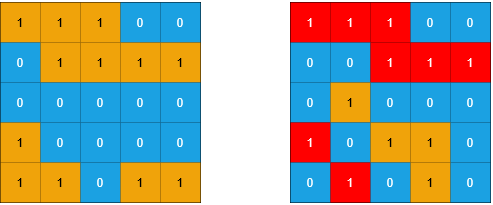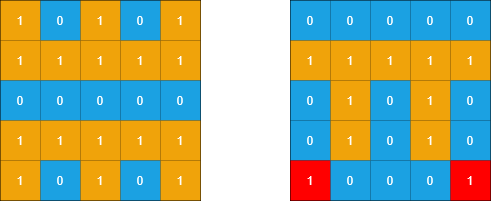Problem 222. Count Complete Tree Nodes
-
Given the
rootof a complete binary tree, return the number of the nodes in the tree. -
According to Wikipedia, every level, except possibly the last, is completely filled in a complete binary tree, and all nodes in the last level are as far left as possible. It can have between
1and2hnodes inclusive at the last levelh. -
Design an algorithm that runs in less than
O(n)time complexity.
Examples
- Example 1:
- Input: root = [1,2,3,4,5,6]
- Output: 6

- Example 2:
- Input: root = []
- Output: 0
Constraints:
- The number of nodes in the tree is in the range
[0, 5 * 10^4]. 0 <= Node.val <= 5 * 10^4- The tree is guaranteed to be complete.
solution
/**
* Definition for a binary tree node.
* function TreeNode(val, left, right) {
* this.val = (val===undefined ? 0 : val)
* this.left = (left===undefined ? null : left)
* this.right = (right===undefined ? null : right)
* }
*/
/**
* @param {TreeNode} root
* @return {number}
*/
var countNodes = function(root) {
if (!root) return 0;
let count = 1;
count += countNodes(root.left);
count += countNodes(root.right);
return count;
};Problem 1905. Count Sub Islands
-
You are given two
m x nbinary matricesgrid1andgrid2containing only0's (representing water) and1's (representing land). An island is a group of1's connected 4-directionally (horizontal or vertical). Any cells outside of the grid are considered water cells. -
An island in
grid2is considered a sub-island if there is an island ingrid1that contains all the cells that make up this island ingrid2. -
Return the number of islands in
grid2that are considered sub-islands.
Examples

- Example 1:
- Input: grid1 = [[1,1,1,0,0],[0,1,1,1,1],[0,0,0,0,0],[1,0,0,0,0],[1,1,0,1,1]], grid2 = [[1,1,1,0,0],[0,0,1,1,1],[0,1,0,0,0],[1,0,1,1,0],[0,1,0,1,0]]
- Output: 3
- Explanation:
- In the picture above, the grid on the left is grid1 and the grid on the right is grid2.
- The 1s colored red in grid2 are those considered to be part of a sub-island. There are three sub-islands.

- Example 2:
- Input: grid1 = [[1,0,1,0,1],[1,1,1,1,1],[0,0,0,0,0],[1,1,1,1,1],[1,0,1,0,1]], grid2 = [[0,0,0,0,0],[1,1,1,1,1],[0,1,0,1,0],[0,1,0,1,0],[1,0,0,0,1]]
- Output: 2
- Explanation:
- In the picture above, the grid on the left is grid1 and the grid on the right is grid2.
- The 1s colored red in grid2 are those considered to be part of a sub-island. There are two sub-islands.
Constraints:
m == grid1.length == grid2.lengthn == grid1[i].length == grid2[i].length1 <= m, n <= 500grid1[i][j]andgrid2[i][j]are either0or1.
Solution
/**
* @param {number[][]} grid1
* @param {number[][]} grid2
* @return {number}
*/
var countSubIslands = function(grid1, grid2) {
const M = grid2.length;
const N = grid2[0].length;
let count = 0;
let isSubIsland = true;
const dfs = (row, col) => {
if (row < 0 || row >= M || col < 0 || col >= N || grid2[row][col] === 0) {
return;
}
if (grid1[row][col] === 0) {
isSubIsland = false;
return;
}
grid1[row][col] = 0;
grid2[row][col] = 0;
dfs(row + 1, col);
dfs(row - 1, col);
dfs(row, col + 1);
dfs(row, col - 1);
};
for (i = 0; i < M; i++) {
for (j = 0; j < N; j++) {
isSubIsland = true;
if (grid2[i][j] === 1) {
dfs(i, j);
if (isSubIsland) {
count++;
}
}
}
}
return count;
};Problem 647. Palindromic Substrings
-
Given a string
s, return the number of palindromic substrings in it. -
A string is a palindrome when it reads the same backward as forward.
-
A substring is a contiguous sequence of characters within the string.
Examples
-
Example 1:
- Input: s = "abc"
- Output: 3
- Explanation: Three palindromic strings: "a", "b", "c".
-
Example 2:
- Input: s = "aaa"
- Output: 6
- Explanation: Six palindromic strings: "a", "a", "a", "aa", "aa", "aaa".
Constraints
1 <= s.length <= 1000sconsists of lowercase English letters.
Solution
/**
* @param {string} s
* @return {number}
*/
var countSubstrings = function(s) {
let count = 0;
const countPalindrome = (str, start, end) => {
while (start >= 0 && end < str.length && str[start] === str[end]) {
start--;
end++;
count++;
}
};
for (let i = 0; i < s.length; i++) {
countPalindrome(s, i, i); // odd-length palindromes
countPalindrome(s, i, i+1); // even-length palindromes
}
return count;
};
dddd